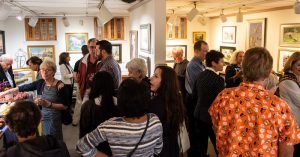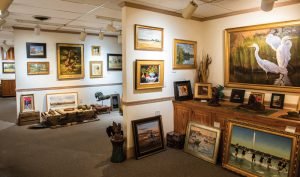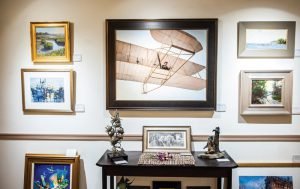+ By Christine Fillat + Photos by Alison Harbaugh
Close to Church Circle, near the top of Annapolis’ Main Street, sits McBride Gallery. Framed artworks are displayed in the storefront’s windows, and inside, oil paintings share space with watercolors, pastels, ceramics, and small sculptures. The gallery’s seven rooms are traversed in a circle—its walls lined with masterfully created artworks. The space resembles someone’s home, with furniture placed here and there. While visually exciting, the atmosphere is decidedly calm, perhaps meditative, a testament to the gallery owner’s discerning vision. This is Cynthia McBride’s world.
McBride has a school of thought governing her gallery shows. Her philosophy is all about the great idea. “Artists have a good painting idea,” she reasons, “and if they have a great painting idea, that’s the start of a wonderful painting.” She applies this concept to organizing her shows, with such titles as Women Artists of the West, Best of the Chesapeake, Looking Back: Memories, and 100 Plein Air Painters of the Mid-Atlantic. Gallery shows have openings on Sunday afternoons, often with live demonstrations or artist talks, and are always well attended.
During the 1960s, McBride grew up on a remote farm in the northern reaches of Minnesota, close to the Canadian border. Farming was a family affair. She and each of her five siblings had their respective chores; her duties involved chopping wood, baling hay, driving the tractor, and cleaning out the barn. Water pumped from the well was heated on the woodstove. The family grew all its own fruit and vegetables and had a self-sustaining farm. “I was [like my dad’s] eldest son. His right-hand man, his hired hand,” McBride jokes. “It was a different life, but very wholesome.”
Paintings adorned the walls in the McBride farmhouse, whereas McBride’s friends’ homes displayed framed images from the pages of magazines. Her family’s home was more like a museum, with original watercolor and oil paintings presenting views of landscapes, farm life, and family members, all painted by McBride’s mother, Frances Karlsson. A trained artist, Karlsson worked in a home studio, where she’d create paintings for various clients. “We would stand in the doorway,” McBride reminisces. “We couldn’t walk in while she was working without being invited. She would look at us and we would say, ‘Can we come in?’ She would say, ‘Yes, but don’t jiggle the table.’ I heard that 100 times or more. We would stand as close as we could but not touch the table.”
A solo show at Lutheran Brotherhood Insurance Company in Minneapolis gave Karlsson an opportunity to present her artwork and share it with the public. “That was important,” states McBride. “She had a couple of things like that, but being so isolated, she didn’t have [many of] those opportunities, and I felt that hurt.”

Art lovers and artists gatherer at McBride Gallery to view the 10 painted violins painted by local artists to raise funds for the Annapolis Symphony Academy.
In 1972, after graduating from college and as a young bride living in Massachusetts, McBride decided to open a small business. “I really hadn’t been in any art galleries, growing up on a farm and then off to college; I’d seen them from the outside, but I thought, ‘I can do that. I know a lot about art,’” she recalls. She opened The Original Gallery in Hull, Massachusetts, selling original artwork and offering custom framing. “When you’re 25 and you’re deciding you’re going to open your first business, you think you can do anything.” She learned how to frame, work in a store, and run a business.
She went on to owning successful galleries in Sewickley (Pennsylvania), Annapolis, and Severna Park, promoting local and nationally known artists and custom framing. The lifestyle suits her; she was able to work while her daughters attended school. A McBride-owned gallery has been a significant presence in the Annapolis art scene since 1978.
McBride developed The Best of the Chesapeake to showcase art made in the mid-Atlantic. Artists come to this area from as far away as Canada for the inspiration of the Chesapeake Bay. This yearly show is juried, with cash prizes to artists in different categories. The show’s artwork is for sale, with prices ranging from $425 to $15,500. Choosing a favorite piece is a matter of personal taste—and, of course, budget.
A show at McBride Gallery is also a learning experience, with interactive talks with the artists. “If you’ve learned something, that’s energizing,” says McBride, explaining why she does this. “A lot of people walk into a gallery, and it’s so staid and dead, you don’t really leave learning anything. [Learning] benefits the customer, the collector, the visitor. The artist benefits. The gallery benefits . . . We all win.”
She takes great pleasure in helping people understand what makes a good painting. “How do I know what’s good?” and “I really don’t know what I like.” are statements she hears often. “Everybody has the ability . . . to appreciate beauty,” says McBride. “What we don’t always recognize is composition and design.” She encourages patrons to trust their eyes to know if something is pleasing or perhaps a bit off.
Gesturing to a landscape painting, McBride points out the places the eye goes to, the places where the sunlight glints and the areas of darkness, and the effect of the intensity of colors. “Look at that red of that barn, there. That’s powerful. It’s cropped, which makes it more intimate, like you’re coming up to it. This is a plein air painting. You’re saying, ‘My eyes want to squint, that sun is so bright.’ Doesn’t that feel bright? It almost makes you want to squint. You can feel sun here, shadow here, it’s believable. That’s the farm I grew up on. That’s my daughter Abigail’s painting. She loves going back, when she can.”
Abigail McBride has a strong presence in her mother’s gallery. A skilled still-life and landscape artist who works in oils, she got her first painting lesson from her grandmother Karlsson on the Minnesota family farm. Many of her paintings are made on trips to visit her 101-year-old grandfather. Thus the family tradition continues.
A work of art represents an encapsulated universe. It is a glimpse into the artist’s sensibility and becomes a conversation between the viewer and the artist. The sun will always be setting or rising, the cow will always be grazing in the field, and the glints of light will perpetually be dazzling on the horizon. This is what living with art is all about. At McBride Gallery, living with beauty is always possible. It is, perhaps, the best Great Idea. █
For more information, visit
www.McBrideGallery.com.





















